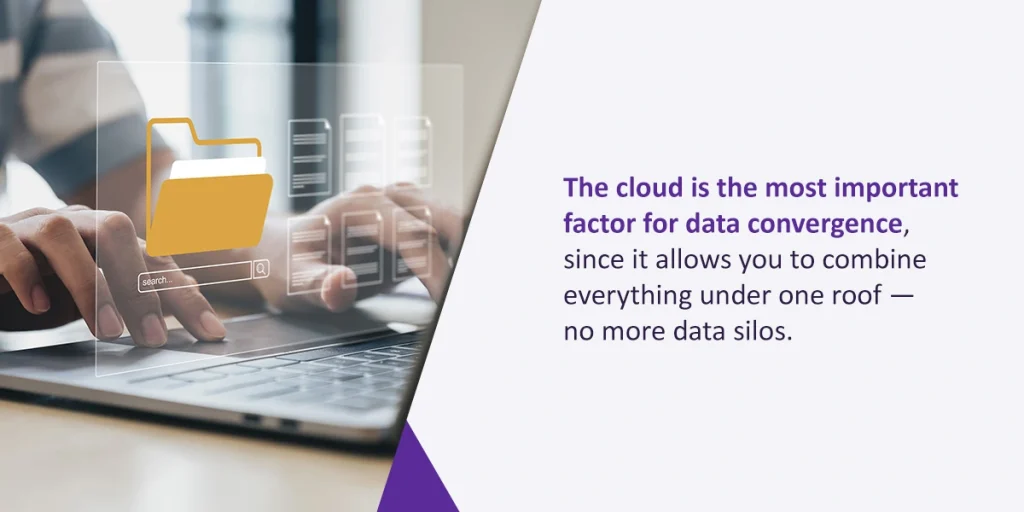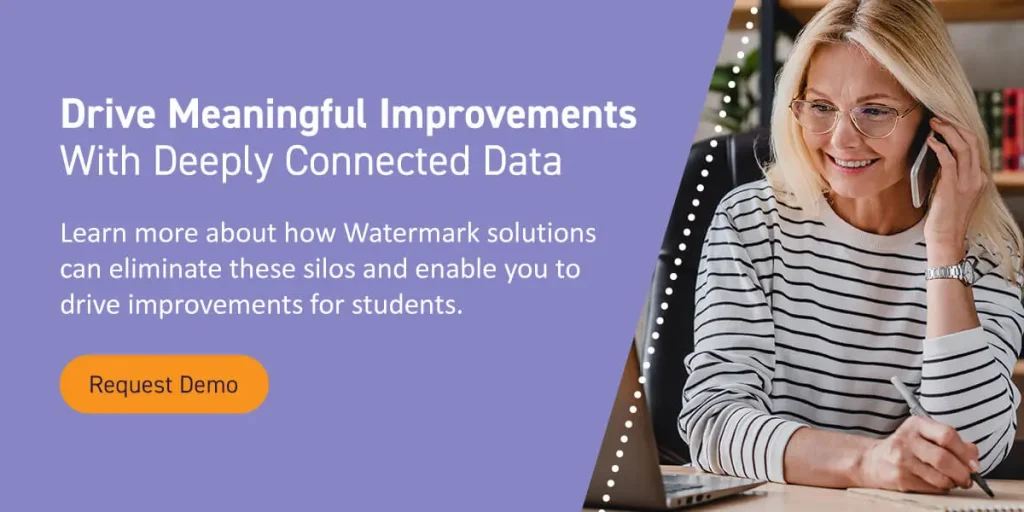Higher education institutions increasingly turn to assessment and curriculum management to find the data needed to support student achievement. Software purpose-built for higher education and other technological advances allow colleges to demonstrate institutional effectiveness.
What Is Data Convergence?
Data convergence refers to the process of consolidating all your institution’s data into one unified cloud system. It’s a simple concept that enables institutions to modernize without sacrificing control of their systems.
The many benefits of digital convergence include:
- Improved data governance: With fewer data applications to manage and maintain, you can reduce the risk of bad data quality and cut costs.
- Enhanced security: Data convergence shrinks your attack surface, reducing the number of entry points available to would-be attackers.
- Increased visibility: Real-time access to data gives you total visibility into every level of your institution, making it easier to understand the rapidly changing needs of your student population.
- Greater scalability: Keeping all your data in one location enables you to scale your resources rapidly to meet increased demand.
- Disaster recovery: The cloud enables you to back all your institution’s data up to multiple geographic locations for secure, efficient recovery after an emergency.
The Challenges of Siloed Data in Higher Education
As higher education institutions adopt more software tools, avoiding data silos becomes increasingly challenging.
Data silos appear when groups — departments, programs, or teams — use disparate systems to store their information. This situation makes siloed data inaccessible to people outside the group, which can:
- Decrease productivity: Users must spend additional time searching for the information they need, which can get in the way of their normal tasks.
- Raise operational costs: The more systems your institution uses, the more it will cost to retain access to them. Plus, there’s a greater risk of data quality issues, like errors and duplicate data, that can slip through the cracks and affect your bottom line.
- Poor student and faculty experience: Lack of access to student and faculty data limits the services your staff can provide, which can negatively impact the campus experience for everyone.
- Inhibit scalability: If you can’t effectively use your data at your current capacity, you’ll also be unable to do so at scale.
- Prohibit inter-department collaboration: When data is siloed in one system, it creates barriers between departments that can hinder your faculty’s ability to work together on research or educational initiatives.

Implementing centralized, cloud-based software solutions eliminate data silos and the problems that come with them. The cloud is the most important factor for data convergence since it allows you to combine everything under one roof — no more data silos.
How to Apply Data-Driven Processes to Higher Education
Higher education institutions can leverage data-driven processes to:
- Improve recruitment and marketing strategies: Better-connected data solutions can help you increase your recruitment strategies’ success and better target your marketing efforts.
- Gauge the success of certain initiatives: Using data trends, you can measure the effectiveness of your decisions.
- Leverage projections and historical trends: Instead of strategizing based on assumptions, advisors can brainstorm ideas based on reports displaying trends and patterns.
- Understand student success and retention rates: Data will illuminate student retention and success rates, such as low retention rates for specific cohorts.
- Intervene with at-risk students: Using data gleaned from trends, instructors can decipher ways to provide additional support and increase the odds of student success and retention.
- Evaluate and enhance curriculum: Data will highlight commonalities and patterns so you can create plans for improvement and revise your goals. For example, do courses with high student dropout rates have anything in common?
- Connect digital channels: Data collected from digital avenues such as mobile apps, websites, email marketing campaigns, and social media accounts can tell you how people are responding to and engaging with your brand.
- Gauge instructor productivity: You can also use data to evaluate whether replacing part-time faculty with full-time instructors would be more cost-efficient.
- Track resources: Optimizing your resources can open up opportunities for reassessment and make your operations more efficient.
Impact of Technology on Higher Education
Better-connected solutions mean improved user experience and efficiency for campuses. Leading-edge platforms empower institutions to gain insight into their most pressing questions. How does a department’s performance measure up to the university’s mission? Are students demonstrating learning outcomes per their career goals and aspirations? Leveraging big data can help you find answers to these questions and more.
Benefits of Data-Driven Culture in Higher Education
The impact of technology on decision-making in higher education has been shown to be advantageous. Data convergence solutions allow college administrators to:
- Establish consistency
- Develop faster decision-making processes
- Speak one common language
- Break down silos
- Allow faculty members wider access to data
- Prioritize student success
- Establish predictive practices
- Streamline operational processes
The Future of Data in Education
Many administrators claim that they would be able to make real change if they only had comprehensive data to work with. The thing is, most higher education institutions already collect massive quantities of data — they just don’t know how to use it effectively.
This disconnect makes sense given how much the rate of change has accelerated over the past decade. In the past, tracking long-term trends through legacy data architectures was enough to make lasting improvements. Today, though, the litany of unprecedented challenges higher education institutions face requires greater institutional agility. Administrators need to consider how they can use all the data they already have at their disposal to get the best insights into the campus experience.
Leveraging more granular data, such as space utilization, Wi-Fi connections, and learning management system (LMS) usage, can help institutions respond more effectively to evolving student and faculty behaviors — which is critical for improving the overall campus experience. The key is to invest in technology that allows you to extract the most meaning from the data you collect.
A user-friendly software solution with advanced analytics capabilities and intuitive data visualizations can provide valuable real-time insights into changing student behaviors so you have the most accurate idea of where your institution can improve. For a seamless implementation, consider how any new technology you adopt will supplement your existing data systems.
Drive Meaningful Improvements With Deeply Connected Data
Watermark understands the growing importance of leveraging data to make informed decisions that positively impact learning outcomes for students. In higher education, each data system has historically been a silo that offers its greatest insights when connected to other data systems.
Learn more about how Watermark solutions can eliminate these silos and enable you to drive improvements for students. Request a customized demo today.















































































































































































































































































































































































































